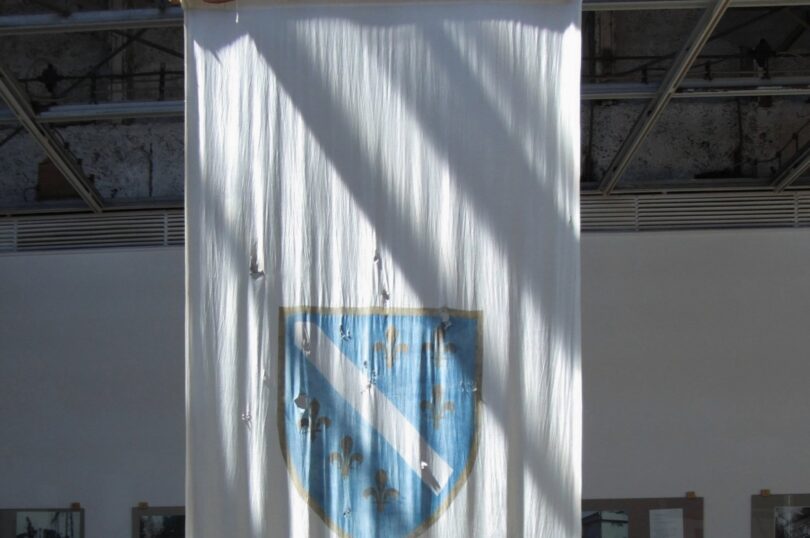SARAJEVO, BOSNIA-HERZEGOVINA (AA) : The golden lilies, once the official flag of Bosnia-Herzegovina following its independence in 1992, underwent alteration postwar. Now displayed in the History Museum, it bears the scars of shrapnel, serving as a poignant reminder of the nation’s tumultuous past.
Bosnia-Herzegovina gained independence from Yugoslavia in referendums held on Feb. 29 and March 1, 1992. While celebrating the 32nd anniversary of its independence, the first flag of the country with a golden lily is on display at the Bosnia-Herzegovina History Museum, with shrapnel marks from the 1992-1995 war.
Historian Enver Imamovic spoke to Anadolu Agency (AA) regarding the first flag with a golden lily, which was hung on the Presidency Building of Bosnia-Herzegovina in May 1992.
Stating that they prepared the flag under hard conditions, Imamovic said, “We found this fabric difficult. It was made of silk. It was very difficult to find it in Sarajevo, which was destroyed and looted. We barely found a white fabric.”
Saying that they found a printing workshop in the Gorica neighborhood of Sarajevo, Imamovic emphasized that Salem Malovic, the workshop owner, printed the flag “under difficult wartime conditions without electricity.”
Imamovic noted that they immediately brought the flag to the Presidential Building.
He continued: “I remember that Ejub Ganic, former member of the Presidency Council of Bosnia-Herzegovina, and many others were there. When we brought and unfurled the flag, everyone was very happy. Ganic helped me place it immediately under the window of the presidency building. Imagine what it means for Sarajevans who have been through all these difficulties to see the new flag, the symbol of the new Bosnia-Herzegovina, in such difficult days.”
Imamovic said that the flag, which flew for only 15 days in the Presidential Building during the war in the country, was damaged by mortar attacks.
“I knew that the flag would have the historical value that it has today. I wrapped it and kept it in my house during the war. When the war ended, I handed it over to the Historical Museum of Bosnia-Herzegovina, and it became the first artifact there,” he added.
“The flag is here now, in front of us, and when I look at it, emotions awaken in me. I will touch it again after all these years,” said Imamovic. “In any European country in the Middle Ages, the lily was used as much as in Bosnia in all aspects of private and public life, in money, jewelry, books and tombstones.”
Imamovic said that the golden lily symbol was removed in 1998, “A big mistake was made.”
Imamovic stated that the flag with the golden lily represents all peoples, not any religious or ethnic group and that it symbolizes people who see themselves as belonging to the country, culture and past.
Imamovic said that he believed the flag would one day be flown again in Bosnia-Herzegovina and continued: “This flag will always be in the hearts of those who love Bosnia-Herzegovina.”
The old flag of Bosnia-Herzegovina, with six golden lilies, was not accepted by other ethnic groups in the country after the end of the war.
Afterward, the flag issue was resolved with the efforts of Carlos Westendorp, the then High Representative of the European Union in Bosnia-Herzegovina, with a law passed on Feb. 3, 1998, despite opposition in Parliament.
Since then, Bosnia-Herzegovina has been represented by a flag with a yellow triangle and white stars on a blue background.







